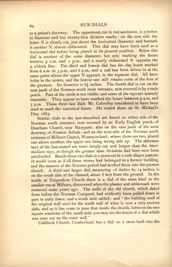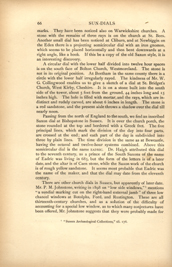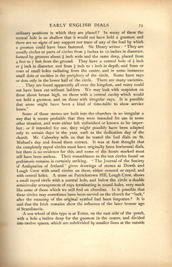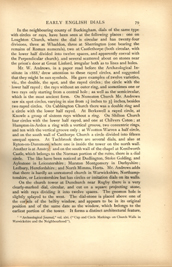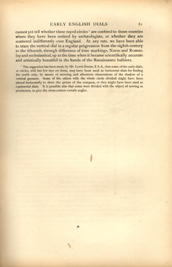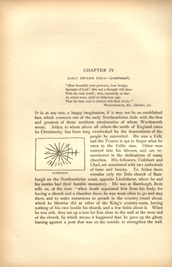
[Full Image]
BAMBURGH.
CHAPTER IV
EARLY ENGLISH DIALS —(continued)
|
"How beautiful your presence, how benign, Servants of God! who not a thought will share With the vain world; who, outwardly as bare As winter trees, yield no fallacious sign That the firm soul is clothed with fruit divine!" |
| WORDSWORTH, Ecc. Sketches, xix. |
IT is, at any rate, a happy imagination, if it may not be an established fact, which connects one of the early Northumbrian dials with the first and greatest of those northern missionaries of whom Wordsworth wrote. Aidan, to whom above all others the north of England owes its Christianity, has been long overlooked by the descendants of the people he converted. He was a Celt, and the Teuton is apt to forget what he owes to the Celtic race. Other men entered into his labours, and are remembered in the dedications of many churches. His followers, Cuthbert and Chad, are associated with two cathedrals of fame and beauty. To Aidan there remains only the little church of Bamburgh on the Northumbrian coast, opposite Lindisfarne, where he and his monks had their humble monastery. He was at Bamburgh, Bede tells us, at the time "when death separated him from his body, for having a church and a chamber there, he was wont often to go and stay there, and to make excursions to preach in the country round about, which he likewise did at other of the King's country-seats, having nothing of his own beside his church, and a few fields about it. When he was sick, they set up a tent for him close to the wall at the west end of the church, by which means it happened that he gave up the ghost, leaning against a post that was on the outside to strengthen the wall
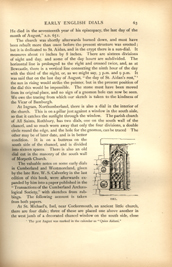
[Full Image]
ISEL.
He died in the seventeenth year of his episcopacy, the last day of the month of August," A.D. 651.
The church was shortly afterwards burned down, and must have been rebuilt more than once before the present structure was erected; but it is dedicated to St Aidan, and in the crypt there is a sun-dial. It measures about 11 inches by 8 inches. There are sixteen divisions of night and day, and some of the day hours are subdivided. The horizontal line is prolonged to the right and crossed twice, and, as at Bewcastle, there is a vertical line connecting the ninth hour of the day with the third of the night, or, as we might say, 3 p.m. and 9 p.m. It was said that on the last day of August, "the day of St. Aidan's rest,"1 the sun in rising would strike the pointer, but in the present position of the dial this would be impossible. The stone must have been moved from its original place, and no sign of a gnomon hole can now be seen. We owe the tracing from which our sketch is taken to the kindness of the Vicar of Bamburgh.
At Ingram, Northumberland, there is also a dial in the interior of the church. This is on a pillar just against a window in the south aisle, so that it catches the sunlight through the window. The parish church of All Saints, Rothbury, has two dials, one on the south wall of the chancel, and so much worn away that only the four divisions, a double circle round the edge, and the hole for the gnomon, can be traced. The other may be of later date, and is in better condition. It is on a buttress on the south side of the chancel, and is divided into sixteen spaces. There is also an old dial cut in the masonry of the south wall of Morpeth Church.
The valuable notes on some early dials in Cumberland and Westmoreland, given by the late Rev. W. S. Calverley in the last edition of this book, were afterwards expanded by him into a paper published in the "Transactions of the Cumberland Archæological Society," with sketches from rubbings. The following account is taken from both papers.
At St. Michael's, Isel, near Cockermouth, an ancient little church, there are four dials; three of these are placed one above another in the west jamb of a decorated chancel window on the south side, close
1 The 31st August was marked in the calendar as "Quies Aidani."
to a priest's doorway. The uppermost, cut in red sandstone, is 5 inches in diameter and has twenty-four division marks; on the east side the letter N is clearly cut, just above the horizontal diameter, and beneath it another N, almost obliterated. This dial may have been used as a horizontal dial before being placed in its present position. Below this dial is another of the same diameter, but only marking the hours betwixt 9 a.m. and 1 p.m., and a nearly obliterated N opposite the 9 o'clock line. The third and lowest dial has the day hours marked from 6 a.m. to 3 p.m., and 6 p.m., and a nail has been driven in at the same point where the upper N appears in the topmost dial. All have holes in the centre, and the lowest one still retains some of the iron of the gnomon. Its diameter is 6 1/4 inches. The fourth dial is cut on the east jamb of the Norman south main entrance, now covered in by a rude porch. Part of the circle is not visible, and some of the rays are scarcely traceable. They appear to have marked the hours between 9 a.m. and 3 p.m. These three last dials Mr. Calverley considered to have been used to mark the canonical hours. He tested them on St. Michaels Day, 1883.
Similar dials to the last-described are found on either side of the Norman south entrance, now covered by an Early English porch, of Dearham Church, near Maryport; also on the east jamb of the west doorway of Newton Arlosh; and on the west side of the Norman south entrance of Milburn Church, Westmoreland; where there are two, placed one above another, the upper one being wrong side up. The alternate rays of the last-named are more deeply cut and longer than the intermediate rays, as though the greater time divisions had here once been subdivided. Beside these two dials is a stone cut in a rude diaper pattern. It would seem as if all these stones had belonged to a former building, and the masons of the Norman period had worked them into the present church. A third and larger dial, measuring 16 inches by 14 inches, is on the south side of the chancel, about 8 feet from the ground. In the inside of Torpenhow Church there is a dial of the same kind as the smaller one at Milburn, discovered when the plaster and whitewash were removed some years ago. The walls of the old church, which dated from before the Norman Conquest, had evidently been pulled down in part in early times, and a south aisle added; and "the building stuff of the original wall used for the south wall of what is now a very ancient aisle, and so it has come to pass that inside the church, between the two square windows of the south aisle, you may see the traces of a dial which was once cut on the outer wall."
Caldbeck Church, Cumberland, has a dial on a stone built into the
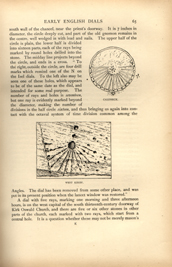
[Full Image]
CALDBECK.
WEST KIRBY.
south wall of the chancel, near the priest's doorway. It is 7 inches in diameter, the circle deeply cut, and part of the old gnomon remains in the centre, well wedged in with lead and nails. The upper half of the circle is plain, the lower half is divided into sixteen parts, each of the rays being marked by round holes drilled into the stone. The midday line projects beyond the circle, and ends in a cross. "To the right, outside the circle, are four drill marks which remind one of the N on the Isel dials. To the left also may be seen one of these holes, which appears to be of the same date as the dial, and intended for some real purpose. The number of rays and holes is seventeen, but one ray is evidently marked beyond the diameter, making the number of divisions in the half circle sixteen, and thus bringing us again into contact with the octaval system of time division common among the Angles. The dial has been removed from some other place, and was put in its present position when the lancet window was restored."
A dial with five rays, marking one morning and three afternoon hours, is on the west capital of the south thirteenth-century doorway of Kirk Oswald Church, and there are five or six other stones in other parts of the church, each marked with two rays, which start from a central hole. It is a question whether these may not be merely mason's
marks. They have been noticed also on Warwickshire churches. A stone with the remains of three rays is on the church at St. Bees. Another small dial has been noticed at Cliburn, and at Newbiggin on the Eden there is a projecting semicircular dial with an iron gnomon, which seems to be placed horizontally and then bent downwards at a right angle, like a hook. If this be a copy of the old Saxon style, it is an interesting discovery.
A circular dial with the lower half divided into twelve hour spaces is on the south face of Bolton Church, Westmoreland. The stone is not in its original position. At Beetham in the same county there is a circle with the lower half irregularly rayed. The kindness of Mr. W. G. Collingwood enables us to give a sketch of a dial at St. Bridget's Church, West Kirby, Cheshire. It is on a stone built into the south side of the tower, about 5 feet from the ground, 44 inches long and 15 inches high. The hole is filled with mortar, and the rays, which are indistinct and rudely carved, are about 6 inches in length. The stone is a red sandstone, and the present aisle throws a shadow over the dial till nearly noon.
Passing from the north of England to the south, we find an inscribed Saxon dial at Bishopstone in Sussex. It is over the church porch, the stone rounded at the top and bordered with a Greek fret. The five principal lines, which mark the division of the day into four parts, are crossed at the end; and each part of the day is subdivided into three by plain lines. The time division is the same as at Bewcastle, having the octaval and twelve-hour systems combined. Above this semicircular dial is the name EADRIC. Dr. Haigh attributed this dial to the seventh century, as a prince of the South Saxons of the name of Eadric was living in 685, but the form of the letters is of a later date, and the altar is of Caen stone, while the Saxon work of the church is of rough yellow sandstone. It seems most probable that Eadric was the name of the maker, and that the dial may date from the eleventh century.
There are other church dials in Sussex, but apparently of later date. Mr. P. M. Johnstone, writing in 1898 on "low side windows,"1 mentions "a sundial marking cut on the right-hand external jamb" of three low chancel windows at Botolphs, Ford, and Rustington. These are all thirteenth-century churches, and as a solution of the difficulty of accounting for a special low window, as to which many conjectures have been offered, Mr. Johnstone suggests that they were probably made for
1 "Sussex Archæological Collections," xli. 176.
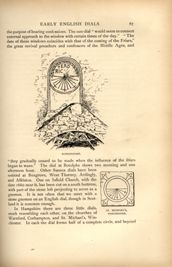
[Full Image]
BISHOPSTONE.
ST. MICHAEL'S, WINCHESTER.
the purpose of hearing confessions. The sun-dial "would seem to connect external approach to the window with certain times of the day." "The date of these windows coincides with that of the coming of the, Friars," the great revival preachers and confessors of the Middle Ages, and "they gradually ceased to be made when the influence of the friars began to wane." The dial at Botolphs shows two morning and one afternoon hour. Other Sussex dials have been noticed at Boxgrove, West Thorney, Ardingly, and Alfriston. One on Isfield Church, with the date 1660 near it, has been cut on a south buttress, with part of the stone left projecting to serve as a gnomon. It is not often that we meet with a stone gnomon on an English dial, though in Scotland it is common enough.
In Hampshire there are three little dials, much resembling each other, on the churches of Warnford, Corhampton, and St. Michael's, Winchester. In each the dial forms half of a complete circle, and beyond
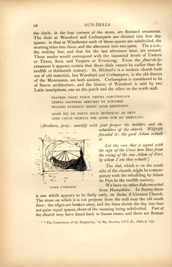
[Full Image]
STOKE D'ABERNON.
the circle, in the four corners of the stone, are floriated ornaments. The dials at Warnford and Corhampton are divided into four day spaces; in that at Winchester each of these spaces are subdivided, the morning tides into three, and the afternoon into two parts. The 9 a.m., the midday line, and that for the last afternoon hour, are crossed. These marks would correspond with the canonical hours of Undern or Tierce, Sext, and Vespers or Evensong. From the fleur-de-lys ornament it appears certain that these dials cannot be earlier than the twelfth or thirteenth century. St. Michael's is a modern church built out of old materials, but Warnford and Corhampton, in the old district of the Meonwaras, are both ancient, Corhampton is considered to be of Saxon architecture, and the history of Warnford is told by two Latin inscriptions, one on the porch and the other on the north wall.
FRATRES ORATI PRECE VESTRA SANCTIFICATE
TEMPLI FACTORES SENIORES ET JUNIORES
WILFRID FUNDAVIT BONUS ADAM RENOVAVIT.
ADAM HIC DE PORTU SOLIS BENEDICAT AB ORTU
GENS CRUCE SIGNATA PER QUEM SUM SIC RENOVATA.
[Brothers, pray; sanctify with your prayer the builders and the rebuilders of the church. Wilfrith founded it; the good Adam rebuilt it.
Let the race that is signed with the sign of the Cross here bless from the rising of the sun Adam of Port, by whom I am thus rebuilt.]
The dial, which is on the south side of the church, might be contemporary with the rebuilding by Adam de Port in the twelfth contury.
We have no other dials recorded from Hampshire. In Surrey there is one which appears to be fairly early, on Stoke d'Abernon Church. The stone on which it is cut projects from the wall near the old south door; the edges are broken away, and the lines divide the day into four not quite equal spaces, those of the morning being subdivided. Part of the church may have dated back to Saxon times, and there are Roman
1 "The Conversion of the Heptarchy," by Bp. Browne, S.P.C.K., 1896, p. 175.
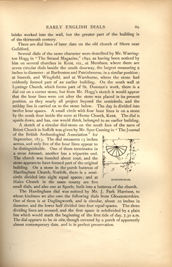
[Full Image]
HARDINGHAM.
bricks worked into the wall, but the greater part of the building is of the thirteenth century.
There are dial lines of later date on the old church of Shere near Guildford.
Several dials of the same character were described by Mr. Warrington Hogg in "The Strand Magazine," 1892, as having been noticed by him on several churches in Kent, viz., at Mersham, where there are seven circular dials beside the south doorway, the largest measuring 9 inches in diameter; at Barfreston and Patrixbourne, in a similar position; at Smeeth, and Wingfield, and at Warehorne, where the stone had evidently formed part of an earlier building. On the south wall at Lyminge Church, which forms part of St. Dunstan's work, there is a dial cut on a corner stone, but from Mr. Hogg's sketch it would appear that the hour lines were cut after the stone was placed in its present position, as they nearly all project beyond the semicircle, and the midday line is carried on to the stone below. The day is divided into twelve hour spaces. A small circle with four hour lines is on a stone by the south door inside the nave at Herne Church, Kent. The dial is upside down, and has, one would think, belonged to an earlier building.
A sketch of a circular dial-stone on the south face of the nave of Bricet Church in Suffolk was given by Mr. Syer Cuming in "The Journal of the British Archæological Association" for September, 1873. The dial measures 15 inches across, and only five of the hour lines appear to be distinguishable. One of them terminates in a cross botonnée, another has a tripartite end. The church was founded about 1096, and the stone appears to have formed part of the original building. On a stone in the porch buttress of Hardingham Church, Norfolk, there is a semicircle divided into eight equal spaces; and at Hales Church in the same county are five small dials, and also one at Sporle, built into a buttress of the church.
The Hardingham dial was noticed by Mr. J. Park Harrison, to whose kindness we also owe the following dials from Gloucestershire. One of them is at Daglingworth, and is circular, about 10 inches in diameter, and the lower half divided into four equal spaces. The three dividing lines are crossed, and the first space is subdivided by a plain line which would mark the beginning of the first tide of day, 7.30 a.m. The dial appears to be in situ, though covered by a porch of apparently almost contemporary date, and is in perfect preservation.
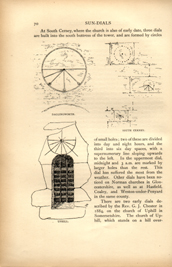
[Full Image]
DAGLINGWORTH.
SOUTH CERNEY.
UPHILL.
At South Cerney, where the church is also of early date, three dials are built into the south buttress of the tower, and are formed by circles of small holes; two of these are divided into day and night hours, and the third into six day spaces, with a supernumerary line sloping upwards to the left. In the uppermost dial, midnight and 3 a.m. are marked by larger holes than the rest. This dial has suffered the most from the weather. Other dials have been noticed on Norman churches in Gloucestershire, as well as at Hasfield, Coaley, and Weston-under-Penyard in the same county.
There are two early dials described by the Rev. G. J. Chester in 1884, on the church of Uphill in Somersetshire. The church of Uphill, which stands on a hill over-
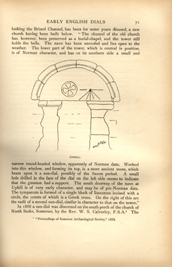
[Full Image]
UPHILL.
looking the Bristol Channel, has been for some years disused, a new church having been built below. "The chancel of the old church has, however, been preserved as a burial-chapel, and the tower still holds the bells. The nave has been unroofed and lies open to the weather. The lower part of the tower, which is central in position, is of Norman character, and has on its southern side a small and narrow round-headed window, apparently of Norman date. Worked into this window, and forming its top, is a more ancient stone, which bears upon it a sun-dial, possibly of the Saxon period. A small hole drilled in the face of the dial on the left side seems to indicate that the gnomon had a support. The south doorway of the nave at Uphill is of very early character, and may be of pre-Norman date. The tympanum is formed of a single block of limestone incised with a circle, the centre of which is a Greek cross. On the right of this are the radii of a second sun-dial, similar in character to that on the tower."
In 1888 a sun-dial was discerned on the south porch of the church of North Stoke, Somerset, by the Rev. W. S. Calverley, F.S.A1 The
1 "Proceedings of Somerset Archæological Society," 1888.
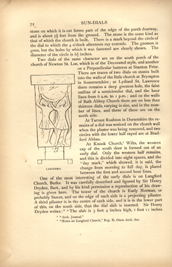
[Full Image]
LANGFORD.
stone on which it is cut forms part of the edge of the porch doorway, and is about 5 ½ feet from the ground. The stone is the same kind as that of which the church is built. There is a mark beyond the circle of the dial to which the 4 o'clock afternoon ray extends. The gnomon is gone, but the holes by which it was fastened are clearly shown. The diameter of the circle is 6 ½ inches.
Two dials of the same character are on the south porch of the church of Newton St. Loe, which is of the Decorated style, and another on a Perpendicular buttress at Stanton Prior. There are traces of two dials on stones built into the walls of the little church at Brympton in Somersetshire; at Lydiard St. Lawrence there remains a deep gnomon hole, the faint outline of a semicircular dial, and the hour lines from 6 a.m. to 1 p.m.; and on the walls of Bath Abbey Church there are no less than thirteen dials, varying in size, and in the number of lines, and three of these are on the north side.
At Tarrant Rushton in Dorsetshire the remains of a dial was noticed on the church wall when the plaster was being removed, and two circles with the lower half rayed are at Bradford Abbas.
At Knook Church,1 Wilts, the western cap of the south door is formed out of an early dial. Only the western half remains, and this is divided into eight spaces, and the "day mark," which showed, it is said, the change from morning to full day, is placed between the first and second hour lines.
One of the most interesting of the early dials is on Langford Church, Berks. It was carefully described and figured by Sir Henry Dryden, Bart., and by his kind permission a reproduction of his drawing is given here. The tower of the church is Early Norman, or probably Saxon, and on the edge of each side is a projecting pilaster. A third pilaster is in the centre of each side, and it is in the lower part of this, on the south side, that the dial slab is inserted. Sir Henry Dryden writes:2 "The slab is 3 feet 4 inches high, 1 foot 11 inches
1 "Arch. Journal."
2 "Notes on Langford Church," Rep. N. Oxon Arch. Soc.
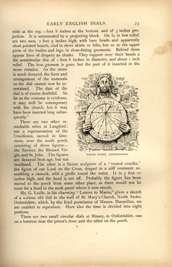
[Full Image]
NORTH STOKE, OXFORDSHIRE.
wide at the top, 1 foot 8 inches at the bottom, and of 3 inches projection. It is surmounted by a projecting block. On it, in low relief, are two men, 2 feet 9 inches high, with bare heads and apparently short pointed beards, clad in short skirts or kilts, but as to the upper parts of the bodies and legs, in close-fitting garments. Behind them appear lines of drapery as cloaks. They support over their heads a flat semicircular disc of 1 foot 8 inches in diameter, and about 1 inch relief. The iron gnomon is gone, but the part of it inserted in the stone remains. As the stone is much decayed, the form and arrangement of the numerals on the dial cannot now be ascertained. The date of the dial is of course doubtful. So far as the costume is evidence, it may well be cotemporary with the church, but it may have been inserted long subsequently."
There are two other remarkable relics at Langford; one a representation of the Crucifixion, carved in limestone, over the south porch, consisting of three figures — the Saviour, the Blessed Virgin, and St. John. The figures are decayed from age, but not mutilated. The other is a Saxon sculpture of a "vested crucifix," the figure of our Lord on the Cross, draped in a stiff vestment resembling a cassock, with a girdle round the waist. It is 5 feet 10 inches high, and the head is cut off. Probably the figure has been moved to the porch from some other place, as there would not be room for a head in the sunk panel where it now stands.
Mr. G. Leslie, in his charming "Letters to Marco," gives a sketch of a curious old dial in the wall of St. Mary's Church, North Stoke, Oxfordshire, which, by the kind permission of Messrs. Macmillan, we are enabled to reproduce. Here also the time is divided into eight portions.
There are two small circular dials at Binsey, in Oxfordshire, one on a buttress near the priest's door, and the other on the porch.
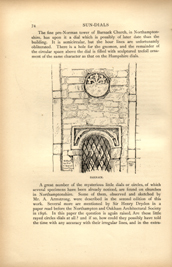
[Full Image]
BARNACK.
The fine pre-Norman tower of Barnack Church, in Northamptonshire, has upon it a dial which is possibly of later date than the building. It is semicircular, but the hour lines are unfortunately obliterated. There is a hole for the gnomon, and the remainder of the circular space above the dial is filled with sculptured trefoil ornament of the same character as that on the Hampshire dials.
A great number of the mysterious little dials or circles, of which several specimens have been already noticed, are found on churches in Northamptonshire. Some of them, observed and sketched by Mr. A. Armstrong, were described in the second edition of this work. Several more are mentioned by Sir Henry Dryden in a paper read before the Northampton and Oakham Architectural Society in 1896. In this paper the question is again raised, Are these little rayed circles dials at all? and if so, how could they possibly have told the time with any accuracy with their irregular lines, and in the extra-
ordinary positions in which they are placed? In many of them the central hole is so shallow that it would not have held a gnomon, and there are no signs of any support nor trace of any of the lead by which a gnomon could have been fastened. Sir Henry writes: "They are usually circles or parts of circles from 3 inches to 10 inches in diameter, formed by grooves about 1/8 inch wide and the same deep, placed from 4 feet to 7 feet from the ground. They have a central hole of ½ inch or 3/4 inch in diameter, and from 3/4 inch to 1 inch in depth, and lines or rows of small holes radiating from the centre, and in some instances small dots or cavities in the periphery of the circle. Some have rays or dots only in the lower half of the circle. There are many varieties.... They are found apparently all over the kingdom, and many could not have been cut without ladders. We may look with suspicion on those about breast high, on those with a central cavity which would not hold a gnomon, and on those with irregular rays. It is possible that some might have been a kind of time-table to show service hours."
Some of these stones are built into the churches in so irregular a way that it seems probable that they were intended for use in some other situation, and were either left unfinished or known to be imperfect; or if intended for use, they might possibly have been adapted only to certain days in the year, such as the dedication day of the church. Mr. Calverley tells us that he tested the Isel dials on St. Michaels day and found them correct. It was at first thought that the completely rayed circles must have originally been horizontal dials, but there is no evidence for this, and some of the hours marked must still have been useless. Their resemblance to the sun circles found on prehistoric remains is certainly striking. "The Journal of the Society of Antiquaries of Ireland" gives drawings of stones at Dowth and Lough Crew with small circles on them, either crossed or rayed, and with central holes. A stone on Patrickstown Hill, Lough Crew, shows a small rayed circle with a central hole, and below the circle a double semicircular arrangement of rays terminating in round holes, very much like some of those which we still find on churches. Is it possible that these circles may sometimes have been carved on the church for "luck," after the meaning of the original symbol had been forgotten? It is said that the Irish remains show the influence of the later bronze age of Scandinavia.
A sun-wheel of this type is at Ecton, on the east side of the porch, with a hole 4 inches deep for the gnomon in the centre, and divided into twelve spaces, which are subdivided by smaller lines at the outside
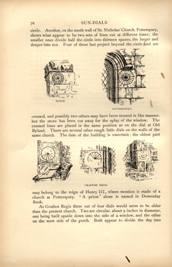
[Full Image]
ECTON.
POTTERSPURY.
GRAFTON REGIS.
circle. Another, on the south wall of St. Nicholas' Church, Potterspury, shows what appear to be two sets of lines cut at different times; the smaller ones divide half the circle into thirteen spaces, the larger and deeper into ten. Four of these last project beyond the circle and are crossed, and possibly two others may have been treated in like manner, but the stone has been cut away for the splay of the window. The crossed lines are placed in the same position as on the dial at Old Byland. There are several other rough little dials on the walls of the same church. The date of the building is uncertain; the oldest part may belong to the reign of Henry III., where mention is made of a church at Potterspury. "A priest" alone is named in Domesday Book.
At Grafton Regis three out of four dials would seem to be older than the present church. Two are circular, about 9 inches in diameter, one being built upside down into the side of a window, and the other on the west side of the porch. Both appear to divide the day into
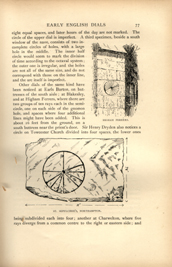
[Full Image]
HIGHAM FERRERS.
ST. SEPULCHRE'S, NORTHAMPTON.
eight equal spaces, and later hours of the day are not marked. The circle of the upper dial is imperfect. A third specimen, beside a south window of the nave, consists of two incomplete circles of holes, with a large hole in the middle. The inner half circle would seem to mark the division of time according to the octaval system; the outer one is irregular, and the holes are not all of the same size, and do not correspond with those on the inner line, and the arc itself is imperfect.
Other dials of the same kind have been noticed at Earls Barton, on buttresses of the south aisle; at Blakesley, and at Higham Ferrers, where there are two groups of ten rays each in the semicircle, one on each side of the gnomon hole, and spaces where four additional lines might have been added. This is about 16 feet from the ground, on a south buttress near the priest's door. Sir Henry Dryden also notices a circle on Towcester Church divided into four spaces, the lower ones being subdivided each into four; another at Charwelton, where five rays diverge from a common centre to the right or eastern side; and
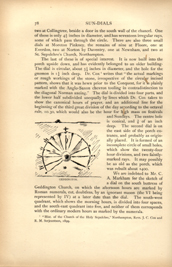
[Full Image]
GEDDINGTON.
two at Collingtree, beside a door in the south wall of the chancel. One of these is only 4 ½ inches in diameter, and has seventeen irregular rays, some of which pass through the circle. There are also three small dials at Moreton Pinkney, the remains of nine at Floore, one at Everdon, two at Norton by Daventry, one at Newnham, and two at St. Sepulchre's Church, Northampton.
The last of these is of special interest. It is now built into the porch upside down, and has evidently belonged to an older building. The dial is circular, about 5 1/4 inches in diameter, and the hole for the gnomon is 1 1/4 inch deep. Dr. Cox1 writes that "the actual markings or rough workings of the stone, irrespective of the circular incised pattern, shows that it was hewn prior to the Conquest, for it is plainly marked with the Anglo-Saxon chevron tooling in contradistinction to the diagonal Norman axeing." The dial is divided into four parts, and the lower half subdivided unequally by lines which Dr. Cox takes to show the canonical hours of prayer, and an additional line for the beginning of the third great division of the day according to the octaval rule, 10.30, which would also be the hour for high mass on festivals and Sundays. The centre hole is conical, and 3/4 of an inch deep. The second dial is on the east side of the porch entrance, and probably as originally placed. It is formed of an incomplete circle of small holes, which show the twenty-four hour divisions, and two faintly-marked rays. It may possibly be as old as the porch, which was rebuilt about 1400.
We are indebted to Mr. C. A. Markham for the sketch of a dial on the south buttress of Geddington Church, on which the afternoon hours are marked by Roman numerals, cut, doubtless, by an ignorant mason (the VI being represented by IV) at a later date than the dial. The south-west quadrant, which shows the morning hours, is divided into four spaces, and the south-east quadrant into five, and neither of them corresponds with the ordinary modern hours as marked by the numerals.
1 "Hist, of the Church of the Holy Sepulchre," Northampton, Revs. J. C. Cox and R. M. Serjeantson, 1899.
In the neighbouring county of Buckingham, dials of the same type with circles or rays, have been seen at the following places: one on Loughton Church, where the dial is circular and has twenty-four divisions, three at Whaddon, three at Sherrington (one bearing the remains of Roman numerals), two at Castlethorpe (both circular, with the lower half divided into twelve spaces, and apparently coeval with the Perpendicular church), and several scattered about on stones near the priest's door at Great Linford, irregular both as to lines and holes.
Mr. W. Andrews, in a paper read before the Archæological Institute in 1888,1 drew attention to these rayed circles, and suggested that they might be sun symbols. He gave examples of twelve varieties, viz., the double, the spot, and the rayed circles; the circle with the lower half rayed; the rays without an outer ring, and sometimes one or two rays only starting from a central hole; as well as the semicircular, which is the most ancient form. On Nuneaton Church Mr. Andrews saw six spot circles, varying in size from 1 3/4 inches to 3 1/4 inches, besides two rayed circles. On Cubbington Church there was a double ring and a circle with the lower half rayed. At Berkswell a rayed circle, at Knowle a group of sixteen rays without a ring. On Shilton Church four circles with the lower half rayed, and one at Chilvers Coton; at Hampton-in-Arden a ring with a vertical groove, two concentric rings, and ten with the vertical groove only; at Wootton Warren a half circle, and on the south wall of Catthorpe Church a circle divided into fifteen unequal spaces. At Tachbrook there are several dials, and also at Ryton-on-Dunsmore, where one is inside the tower on the north wall. Another is at Anstey; and on the south wall of the chapel at Kenilworth Castle, which belongs to the Norman portion of the ruins, there is a dial circle. The like have been noticed at Dudlington, Stoke Golding, and Aylestone in Leicestershire; Marston Montgomery in Derbyshire; Ledbury, Herefordshire; and North Mimms, Herts. Mr. Andrews adds that there is hardly an unrestored church in Warwickshire, Northamptonshire, or Leicestershire but has circles or imitation dials on its walls.
On the church tower at Dunchurch near Rugby there is a very clearly-marked dial, circular, and cut on a square projecting stone, and with rays dividing it into twelve spaces. The gnomon hole is slightly splayed to the west. The dial-stone is placed above one of the corbels of the belfry window, and appears to be in its original position and of the same date as the window, which belongs to the earliest portion of the tower. It forms a distinct architectural feature,
1 "Archæological Journal," vol. xlvi. ("Cup and Circle Markings on Church Walls in Warwickshire and the Neighbourhood").
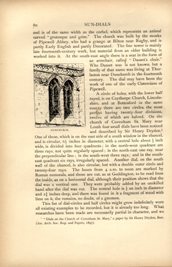
[Full Image]
DUNCHURCH.
and is of the same width as the corbel, which represents an animal carved "grotesque and grim." The church was built by the monks of Pipewell Abbey, who had a grange at Bilton near Rugby, and is partly Early English and partly Decorated. The fine tower is mainly late fourteenth-century work, but material from an older building is worked into it. At the south-east angle there is a seat in the form of an armchair, called "Dasset's chair." Who Dasset was is not known, but a family of that name was living at Thurlaston near Dunchurch in the fourteenth century. The dial may have been the work of one of the early Cistercians of Pipewell.
A circle of holes, with the lower half rayed, is on Caythorpe Church, Lincolnshire, and at Bottesford in the same county there are two circles, the most perfect having twenty-four divisions, twelve of which are halved. On the church of Covenham St. Mary near Louth four small dials have been noticed and described by Sir Henry Dryden1 One of these, which is on the east side of a south window in the chancel, and is circular, 6 ½ inches in diameter, with a central hole about ½ inch wide, is divided into four quadrants; in the north-west quadrant are three rays, not quite regularly spaced; in the north-east one ray, near the perpendicular line; in the south-west three rays; and in the southeast quadrant six rays, irregularly spaced. Another dial, on the south wall of the chancel, is also circular, but with a double outer circle and twenty-four rays. The hours from 4 a.m. to noon are marked by Roman numerals, and these are cut, as at Geddington, to be read from the inside, as on a horizontal dial, although their position shows that the dial was a vertical one. They were probably added by an unskilled hand after the dial was cut. The central hole is ½ an inch in diameter and 2 1/4 inches deep, and there was found in it a fragment of wood with lime on it, the remains, no doubt, of a gnomon.
This list of dial-circles and half circles might grow indefinitely were all existing examples to be recorded, but it is already too long. What researches have been made are necessarily partial in character, and we
1 "Dials on the Church of Covenham St. Mary," a paper by Sir Henry Dryden, Bart. (Ass. Arch. Soc. Rep. and Papers, 1897).
cannot yet tell whether these rayed circles1 are confined to those counties where they have been noticed by archæologists, or whether they are scattered indifferently over England. At any rate, we have been able to trace the vertical dial in a regular progression from the eighth century to the fifteenth, through difference of time markings, Norse and Roman, lay and ecclesiastical, up to the time when it became scientifically accurate and artistically beautiful in the hands of the Renaissance builders.
1 The suggestion has been made by Mr. Lewis Evans, F.S.A., that some of the early dials, or circles, with but few rays on them, may have been used as horizontal dials for finding the north only, by means of morning and afternoon observations of the shadow of a vertical gnomon. Some of the others with the whole circle divided might have been placed horizontally to show the points of the compass, or they might have been used as equinoctial dials. It is possible also that some were divided with the object of serving as protractors, to give the stone-cutters certain angles.
